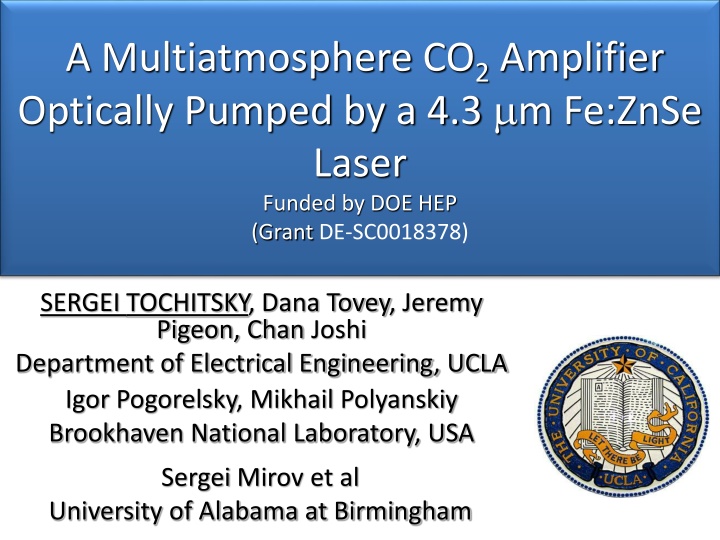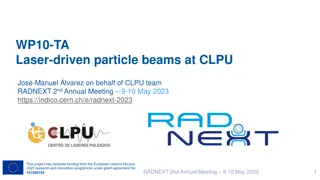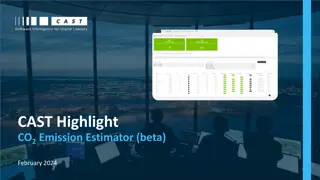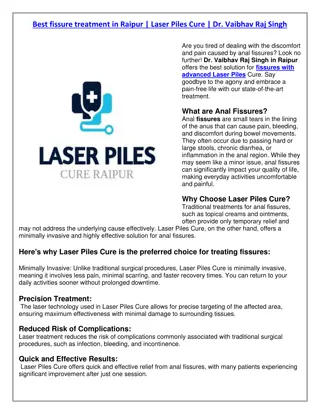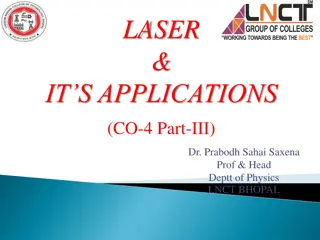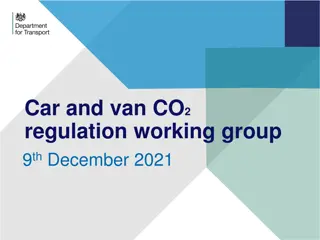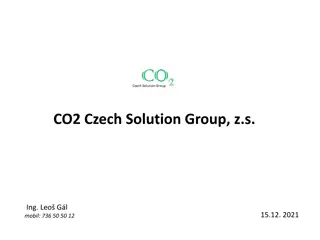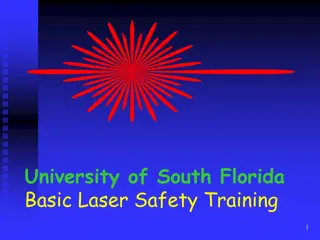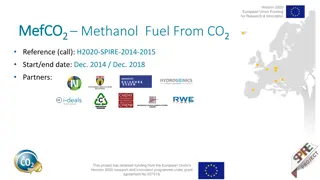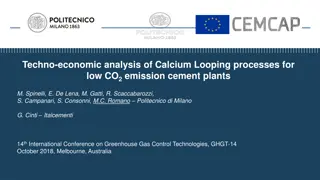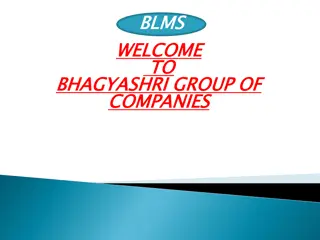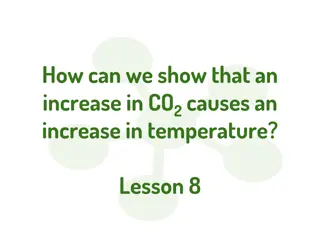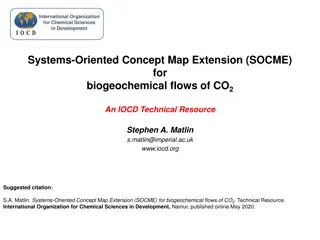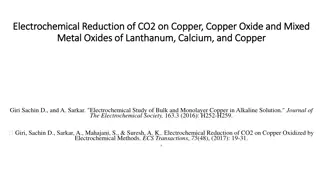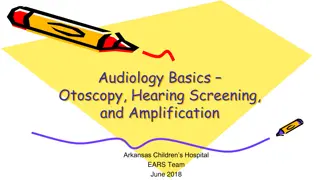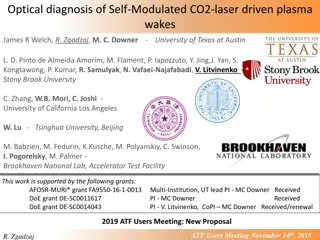Multiatmosphere CO2 Laser Amplification Funded by Department of Energy
A project funded by DOE HEP focuses on developing a multiatmosphere CO2 amplifier optically pumped by a 4.3m Fe:ZnSe laser. The motivation lies in exploring the potential of optically pumped CO2 lasers for generating picosecond pulses at a high repetition rate. The project involves a collaboration between BNL/UCLA and UAB, aiming to enhance particle acceleration and radiation generation using mid-IR ultrafast lasers. Key aspects include CO2 molecule bandwidth, gain spectrum, and techniques for achieving single picosecond pulses. The recipe for success involves maximizing the gain of the CO2 laser and optimizing molecular population levels. Continuous wavelength tunability and performance characteristics of different CO2 laser systems are also discussed.
Uploaded on Sep 15, 2024 | 2 Views
Download Presentation

Please find below an Image/Link to download the presentation.
The content on the website is provided AS IS for your information and personal use only. It may not be sold, licensed, or shared on other websites without obtaining consent from the author.If you encounter any issues during the download, it is possible that the publisher has removed the file from their server.
You are allowed to download the files provided on this website for personal or commercial use, subject to the condition that they are used lawfully. All files are the property of their respective owners.
The content on the website is provided AS IS for your information and personal use only. It may not be sold, licensed, or shared on other websites without obtaining consent from the author.
E N D
Presentation Transcript
A Multiatmosphere CO2 Amplifier Optically Pumped by a 4.3 m Fe:ZnSe Laser Funded by DOE HEP (Grant DE-SC0018378) SERGEI TOCHITSKY, Dana Tovey, Jeremy Pigeon, Chan Joshi Department of Electrical Engineering, UCLA Igor Pogorelsky, Mikhail Polyanskiy Brookhaven National Laboratory, USA Sergei Mirov et al University of Alabama at Birmingham
Motivation Long-wavelength Infrared range is attractive for particle acceleration and radiation generation. At present we experience a Renaissance of mid-IR ultrafast lasers mainly based on OPA and OPCPA in nonlinear crystals pumped at 1-2 m. CO2 laser is efficient and is able to store a great deal of energy within the active medium. The shortest pulse demonstrated so far is ~3 ps and all high-power picosecond systems operate in a single-shot mode limited by electrical discharge stability in a high pressure molecular gas. We would like to explore potential of Optically Pumped CO2 laser for production of 0.3-1 ps pulses at a high- repetition rate. A collaborative effort of BNL/UCLA (gas lasers) built around the state-of the art mid-IR solid-state lasers developed at UAB. ATF User s 2017
CO2 Molecule Bandwidth O C O Boltzman Distribution N0001=[NCO2exp( hv3/kT3)]/Qv col=3.5 GHz x atm 10 m 0001 9 m At 10 atm 35 GHz > 55GHz line spacing 1000 0200 0000 CO2 Gain Spectrum 1 Normalized Ampl.. 0.8 1atm 10atm 25atm Normalized Gain ~1.2THz 0.6 0.4 0.2 0 10.4 10.6 10.8 11 10.4 10.6 Wavelength ( m) 10.8 11 10.4 10.6 10.8 11 Wavelength ( m) ATF User s 2017
Single Picosecond Pulses due to CO2 Isotopes Simulations Experiment Single ~3 ps Regenerative Amplifier Polyanskiy et al. Optics Express 19:7717 (2011)
Optically Pumped CO2 Laser Recipe for success: High-gain CO2 laser Population of 001 level Maximized Population of 100 level Minimized CO2 Molecule ATF User s 2017
OP CO2 Laser: Continuous wavelength tunability HBr Laser (Bell Labs 70s) =4.2-4.45 m, E line ~1-10 mJ CO2 pressure 20-30 atm Small absorption length of 1 cm Up to 40% at 1 atm 4.3 m CO2 Laser (NRC, IP Minsk 80s) =4.25 m, E =2-15 mJ CO2 pressure 1 atm Gain 10-17% cm Importance of 00n-10n-1 channels ATF User s 2017
Multiatmosphere CO2 laser at BNL 4.3 m MOPA system at 20 Hz (UAB) 4.3 m multipass Power Amplifier 2 mJ, ~100 ns, 100-300 mJ 4.3 m Master Oscillator EO-Q-switched, 2 mJ, ~100 ns 4.3 m Pump Pulse 10 m OPA system at ATF BNL 20 atm CO2 10 m 1-10 mJ 0.3-3 ps 10 m Seed Pulse Compressor er Proof-of-principle demonstration of a picosecond CO2 OPML. ATF User s 2017
Preliminary Modeling 10R-branch 20 atm A 5 cm CO2-He cell pumped at 4.2 m Code modification: Take into account 010-011 & 100-101 bands. Non-Boltzman distribution of vibrational population in v3 mode of CO2. ATF User s 2017
Gain Tailoring in CO2 Isotopic Mix Mix of 12CO2-13CO2-He. Stable isotope mix Petukhov, Tochitsky et al, Sov. Tech. Phys. Lett1988 267 GW, 2w0=5.3 cm 205 GW, 2w0=5.12 cm We will need a mix with more 12CO2 to compensate lower dipole moment. Amount of isotope is small and BNL has a know-how in handling CO2 isotopes at high pressure. ATF User s 2017
High-pressure CO2 Optically Pumped Amplifier Transverse pump geometry for a 20atm CO2 amplifier is defined by a strong absorption at 4.3 m. Multipass White cell Nx4 passes g=0.1cm-1; L=12x5cm, Eout~4mJ OUT IN J. White, JOSA 1942 ATF is the right place:seed 0.3-1 ps pulses, CPA , isotopes at P 20 atm ATF User s 2017
Summary We propose a CO2 Laser only project already funded by DOE Accelerator Stewardship Program Investigate gain dynamics in a high-pressure optically pumped CO2 active medium using the code. Conduct gain measurements in CO2-He mix optically pumped by 4.3 m, 100 ns Fe:ZnSe laser pulses 1) 1-2 mJ wavelength tunable pump at UCLA and 2) 100-300 mJ at BNL. Benchmark the code against the experimental data on gain and explore potential of the bandwidth increase in a CO2 isotopic mix. Demonstrate amplification of picosecond 10 m pulses in a CO2-He mix and subpicosecond 10 m pulses in a 12CO2- 13CO2-He mix in a high-pressure cell pumped by energetic 4.3 m Fe:ZnSe laser pulses. ATF User s 2017
